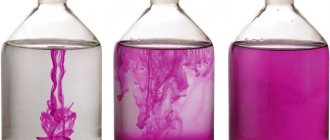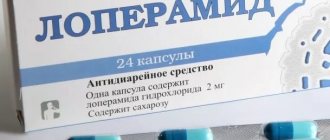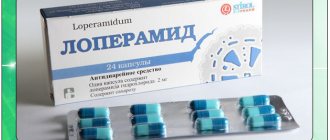Failure of digestive function in the form of a disorder is familiar to many people. The usual course of life is disrupted as soon as diarrhea appears. Effective drugs that can help with the indicated illness will be adsorbent substances or specific medications. There are cases in which the listed funds are not available. Potassium permanganate is an excellent remedy. Potassium permanganate for diarrhea can achieve the desired result in a fairly short period of time.
The effect of potassium permanganate on the body
Potassium permanganate, or potassium permanganate, is the potassium salt of manganese acid. In medicine it is used by dissolving purple crystals in water in different concentrations.
Manganese concentrate has strong oxidizing properties, actively affecting organic compounds. This is what explains the antibacterial and antiseptic ability of potassium permanganate.
The disinfecting effect of the product is determined by the concentration of the active substance in the solution - the richer and darker the color, the higher the concentration of the acid salt in it, and the greater the oxidative effect it has.
In therapy, only dissolved potassium permanganate salt is used. The powder should absolutely not be taken orally or poured onto the skin and mucous membranes. This can cause severe burns to the mucous membranes of the digestive tract or skin.
Pharmacological properties
Potassium permanganate is a purple powder containing tiny crystals. When mixed with water they form a red solution. In medicine, this product is called potassium permanganate.
This product has pronounced antiseptic properties. They are associated with the ability to produce active oxygen upon contact with organic elements - for example, proteins of the human dermis.
The use of potassium permanganate for intoxication is based on the ability to oxidize most compounds of organic and inorganic origin. Potassium permanganate allows you to obtain the following results:
Bile appears in stool: causes and treatment
- Make chemical elements inactive - these include, in particular, alcoholic beverages and their surrogates;
- destroy the cell walls of many microbes that cause intoxication of the body.
How does potassium permanganate work for diarrhea?
If diarrhea develops due to toxins entering the stomach, pathogenic bacteria begin to actively multiply in the lower intestines.
Due to the entry of toxins into the circulatory system, the patient experiences the first symptoms of poisoning: abdominal pain, nausea, vomiting and diarrhea. The main goal of treatment at the initial stage of the disease is to remove food debris from the intestines as soon as possible and destroy pathogenic bacteria. This is exactly how a solution of potassium permanganate works against diarrhea - thanks to the oxidizing ability of the liquid, the activity of pathogenic microorganisms stops, the intestines are cleansed, and the patient’s condition improves. But this solution cannot be recommended for use for all diseases. Before answering the question: is it possible to drink potassium permanganate with diarrhea, you need to determine the cause of the pathology.
You should not drink this remedy if the cause of diarrhea (diarrhea) is not clear, or if there is a suspicion of other pathologies, for example, dysentery or ulcerative colitis.
For acute intestinal diseases, potassium permanganate solution is not used. It is used with caution to treat infants and pregnant women.
To enhance the effect of use, it is recommended to take it orally several times, 2-3 times on the first day of poisoning and 2 times on the second day, even if the result of taking the medicine occurred immediately after the first use.
An enema with potassium permanganate for diarrhea in children is considered no less effective. It will quickly help cleanse the intestines of food debris and the action of potassium permanganate.
Potassium permanganate is also used for gastric lavage.
Potassium permanganate is used for diarrhea in children and adults; this remedy has virtually no contraindications and is considered safe, but only if properly prepared and used!
Indications
Thanks to the action of potassium permanganate, the substance can be used in the following cases:
- Diarrhea – the drug is an intraintestinal antiseptic and has an enveloping effect;
- gastric lavage – can be performed in case of food or chemical intoxication;
- rinsing the mouth - carried out for infectious and inflammatory pathologies;
- douching and rinsing - required in urological and gynecological practice;
- treatment of ulcerative defects and wounds - thanks to this it will be possible to neutralize the inflamed focus.
Preparation of manganese solution for diarrhea
Potassium permanganate for diarrhea is prepared in the same way for adults and children. To obtain a safe and effective product, you need to prepare several containers, a large amount of clean water and manganese crystals. They are added to the first container until the solution turns bright pink. Then about half of the resulting solution is poured into a second container and diluted halfway with clean water. This transfusion is repeated 2-3 times. It is necessary in order to completely prevent the entry of undissolved crystals into the patient’s intestines.
The potassium permanganate solution should be prepared in glass or earthenware containers. If you use utensils made of plastic, iron or steel, marks may remain on them, and potassium permanganate may react chemically with the coating and change its properties.
Calculation of the dose of potassium permanganate can be done by eye - diluting the liquid from dark red to very pale pink or at the rate of 1 g of potassium permanganate per 1 liter of water. It is better to dilute the concentrated solution with warm water, approximately 30-35 degrees.
This weakly concentrated solution is suitable for oral administration or enemas; for treating wounds and burns, it is recommended to use a more concentrated solution - 2 or 5 g per 1 liter of water.
Contraindications
No matter how universal a remedy for diarrhea manganese is, it has a number of contraindications:
- High sensitivity to potassium permanganate . Allergy symptoms are very similar to those resulting from exposure to a concentrated solution. To distinguish one from the other, a skin test is performed. Apply 3-5 drops of a known weak solution to the bend of the elbow and wait 2 hours. If during this time no itching, rash, or swelling appears, then potassium permanganate can be used to treat diarrhea.
- Increased temperature and fever . In such conditions, the use of the product is prohibited.
- Severe vomiting . You should not drink potassium permanganate if diarrhea is accompanied by severe vomiting. In such cases, you can give an enema.
- Blood in feces . If blood clots are found in the stool, potassium permanganate should not be used. Blood in feces most often appears due to damage to the intestinal walls, and in such cases, even a weak solution of potassium permanganate turns into a strong irritant.
- Taking activated carbon . You should not use potassium permanganate while taking activated carbon: taken together, the substances create an alkaline environment. In addition, it is not recommended to combine a solution of potassium permanganate with sugar and tannin.
[adsp-pro-9]
( 1 ratings, average: 5.00 out of 5)
How to take potassium permanganate for diarrhea?
In order for a weak solution of potassium permanganate for diarrhea to be beneficial and not harmful, it must be used correctly. The basic rule is to take pale pink water orally, in small portions, after making sure there is no allergic reaction.
To do this, before the first use, drop a few drops of a dark red solution onto the skin of the wrist or elbow from the inside and wait a few minutes. If no unpleasant symptoms of an allergic reaction appear - no itching, rash, redness, pain, then treatment can be continued.
In addition to drinking a solution of potassium permanganate, it is necessary to take other types of liquid to prevent the development of dehydration.
It is also necessary to remember the need to maintain salt balance in the body. To do this, you can purchase special solutions at the pharmacy or drink rice water or mineral water.
For an adult
Potassium permanganate for diarrhea in adults is used in small doses, not exceeding half a glass two to three times a day, treatment is continued for several days.
The solution is drunk on an empty stomach, in small sips, trying not to induce vomiting.
To kid
Potassium permanganate for a child with diarrhea is prescribed 20-50 ml, depending on age, 2-3 times a day. It is imperative to obtain prior permission for treatment from the attending physician if the child is under 3 years old.
The amount of solution drunk in children should not exceed 100 - 200 ml at a time.
Pregnant women
Pregnant women can use a solution of potassium permanganate for diarrhea, but only after consulting with their doctor.
During pregnancy, diarrhea does not always indicate pathology - in the first trimester it can be one of the symptoms of toxicosis, and in the last weeks before childbirth it is physiological, as the body is cleansed before childbirth.
If diarrhea during pregnancy occurs due to food poisoning or infection, it is recommended that women be treated in a hospital or under the supervision of a doctor, since intoxication and dehydration during this period can be very dangerous for the fetus and mother.
Enema with potassium permanganate for diarrhea
An enema with potassium permanganate is a simple and effective way to cleanse the intestines in children and adults suffering from diarrhea.
To prepare an enema, you need a pale pink warm solution of potassium permanganate, a soft enema with a tip. It is recommended to carry out the procedure in the bathroom; the child is placed on his side, on an oilcloth or disposable diaper, with his legs bent at the knees and brought to his stomach. The enema tip is lubricated with oil or cream and gently, with screwing movements, inserted into the child’s anus 1-2 cm deep. It is important to insert the tip gently and slowly, without causing discomfort in the patient or overcoming resistance.
Enemas for children from one to 3 years of age are given at 30-50 ml, for children over 3 years old - from 50 to 100 ml at a time, for children over 6 years old - from 100 ml.
Water is introduced slowly; After administering the liquid, the enema is carefully removed, the buttocks are held, trying to delay bowel movement for 5-10 minutes. The procedure is repeated until the intestines are completely cleansed and the washing water is pink and free of impurities.
To carry out enemas, it is recommended to prepare in advance from 2 to 10 liters of a warm pale pink solution of potassium permanganate. For young children, 0.3-0.5 liters per wash is enough; for preschoolers, this amount is about 1 liter.
Enemas can be repeated twice on the first day of poisoning, then 1-2 times a day for 2-3 days. It is not recommended to do enemas beyond this period, since a solution of potassium permanganate washes out not only toxins from the intestines, but also beneficial microflora, which can cause digestive problems after recovery. To avoid this, after poisoning and enemas with potassium permanganate, it is recommended to add more fermented milk products to the diet or take drugs to restore intestinal flora: Bifidumbacterin, Linex, Hilak Forte.
Storage
It is recommended to store dry powder in a dark and dry place. It must be remembered that it is highly flammable, so keep it away from fire. In addition, manganese must be hidden from sunlight. It is strictly forbidden to shake the bottle. The container must be tightly closed.
You can’t put sugar or salt next to manganese. The average shelf life of the product is 5 years from the date of manufacture. During this time, the powder retains its medicinal properties.
It is not recommended to store the prepared solution; in extreme cases, it can be left in the refrigerator for a day.
Side effects
Potassium permanganate can harm a child with diarrhea if:
- the preparation rules were violated, the recommended dose was increased;
- with increased sensitivity to the drug.
The rules for preparing and using potassium permanganate solution are described above. Intolerance to potassium permanganate, if there are no signs of allergy during a skin test, can be easily detected at the very beginning of treatment. The patient becomes uncomfortable, painful, nausea and vomiting intensify, and sharp abdominal pain and cramps may occur.
If such symptoms occur, you should immediately stop administering the solution and let the patient drink as much clean water as possible, or do a cleansing enema with clean water.
Among the side effects, the most dangerous is the burning of the mucous membrane by undissolved crystals. When undissolved salt of manganese acid enters the body tissues, it causes severe pain, deterioration of the patient’s condition, and in the most severe cases, bleeding from the intestines.
Other side effects include an overdose of manganese solution. This complication often occurs in people who self-medicate and do not keep track of how much solution they drank. When more than 3-4 glasses of the drug are ingested, nausea, vomiting, abdominal pain and a sharp deterioration in condition occur.
Precautionary measures
Potassium permanganate is a dangerous substance, the use of which requires extreme caution:
- do not use solutions that are too dark, which can cause burns;
- thoroughly dissolve all salt particles, preventing their presence in the solution;
- Do not touch the crystals with unprotected hands and prevent them from getting on the skin and mucous membranes.
It is prohibited to simultaneously use a solution of potassium permanganate orally and use medications that prevent the free passage of intestinal contents. When activated charcoal is used simultaneously in treatment with a solution of potassium permanganate, a violent chemical reaction occurs, as a result of which the intestinal mucosa may be damaged.
A solution of potassium permanganate for diarrhea is an adjuvant and cannot replace full treatment of food poisoning or infection. It can only be used in combination with other medications if the cause of the poisoning is precisely known.
Application
Currently, treatment with a solution of potassium permanganate has begun to be considered an almost folk method. Our grandmothers also used it as a remedy for diarrhea and poisoning. Its action is especially effective in cases of food poisoning and associated intoxication and diarrhea.
The effectiveness of potassium permanganate is due to its pronounced effect on the body. It is known to have antiseptic, anti-inflammatory, antimicrobial and moderate astringent effects.
At the same time, the reader needs to know that it should be handled very carefully, used in moderate doses and only make a weak pinkish solution with completely dissolved crystals.










